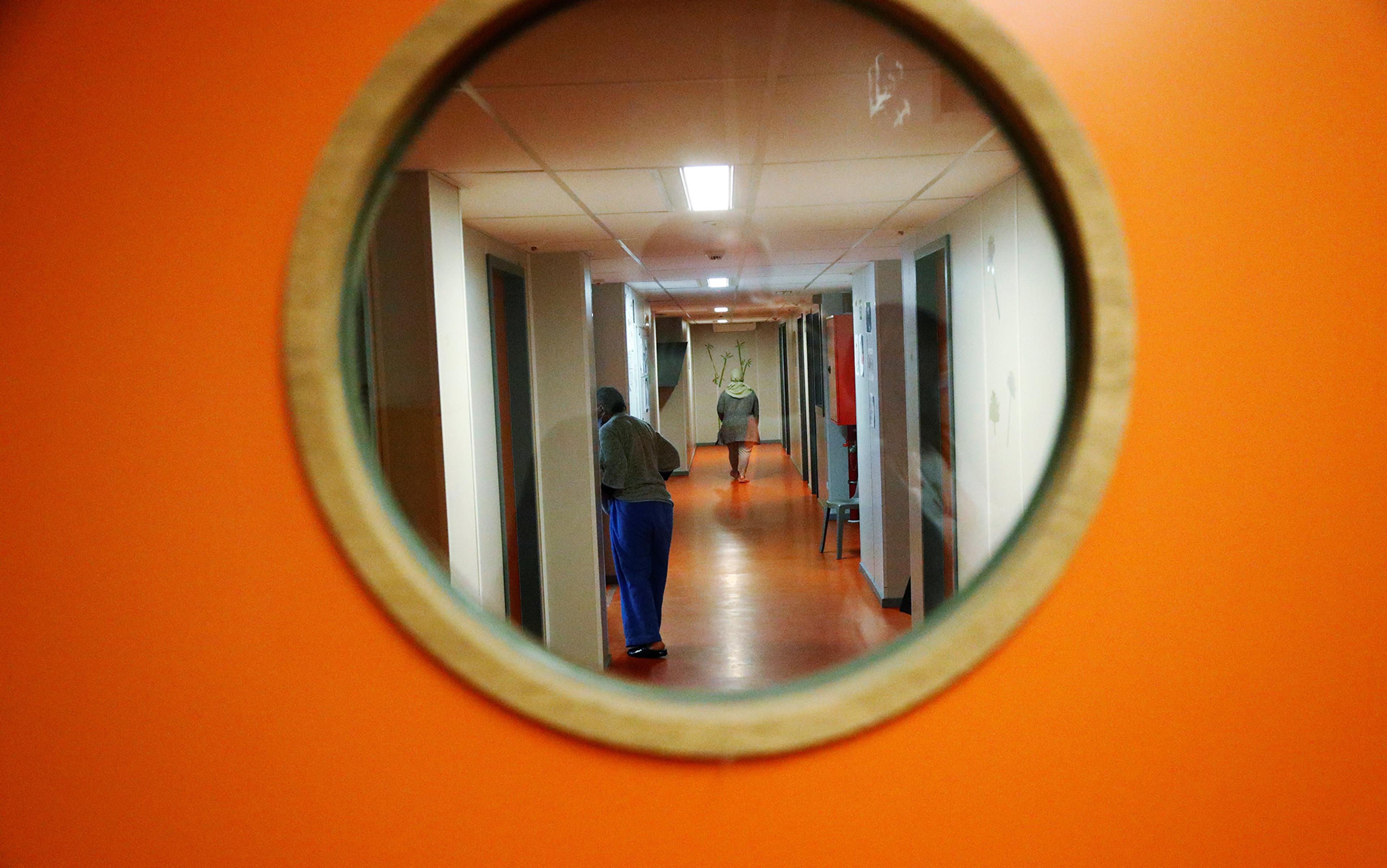The voices told him that he was God, and Oliver believed them. Only 17 years old, he was special, chosen, a higher being whose wisdom and intelligence were beyond compare. Psychiatrists, however, labelled these voices as auditory hallucinations, his first psychotic episode. A diagnosis of schizophrenia soon followed. For the next five years, Oliver would spend weeks in mental institutions and hospitals in northern England where he lived. When he was deemed too aggressive for one facility, he was injected with sedatives, bundled into the back of a van and driven to a higher-security institution. The drugs made the voices distant. Oliver felt subdued and heavy as he fell back to Earth.
Five years have passed. Although he is unemployed, Oliver is now able to live at home with his wife and young daughter. He takes clozapine, an antipsychotic that’s prescribed to patients who don’t respond to two first-line drugs such as olanzapine and quetiapine. It’s a last resort for a reason: clozapine is a toxic medicine that reduces the number of white blood cells in his body, so Oliver has regular blood tests to make sure he isn’t immune-compromised, a concern that has grown during the COVID-19 pandemic.
I haven’t seen Oliver in all this time. I only know what’s been happening to him via his father, my uncle. We’re cousins with just two years between us in age, yet Oliver and I have lived through different – often opposing – experiences of mental disorder. While Oliver felt lifted to the heights, I believed that I was worthless, guilty of ruining the lives of others. Far from being heavenly, I felt I was better off dead and buried. This suicidal ideation, combined with a lack of motivation and baseless guilt, is typical of a mood disorder such as depression. Accordingly, doctors prescribed me antidepressants that adjust the neurotransmitter serotonin in my brain, rather than clozapine or another antipsychotic, which target a different brain chemical, dopamine.
I’ve never been institutionalised or injected with sedatives (although I am prescribed them). I’ve never heard voices in my head. From its symptoms to its treatment, my depression is a gulf apart from Oliver’s schizophrenia. Mine is a mood disorder, not a psychotic disorder. Like the split between animals and plants in biology, these two fundamental categories have been a cornerstone of psychiatry since the work of the German psychiatrist Emil Kraepelin in the late-19th and early 20th centuries. His textbooks laid the foundations for the DSM-5 and the ICD-11 – the latest editions of two reference manuals published by the American Psychiatric Association and the World Health Organization, respectively – that are used by psychiatrists to diagnose hundreds of different mental disorders, each grouped into 20 or so categories: disorders of personality, psychosis, substance use, anxiety, depression, eating, sexual dysfunction and so on.
Since the publication of the DSM-III in 1980, psychiatric diagnosis has helped to select the right treatment for a person’s symptoms. It’s also made the tracking of diagnoses over time and space possible, a field known as ‘psychiatric epidemiology’. However, while these diagnostic guides might be useful for doctors who must make daily decisions about care and treatment, some critics argue that diagnostic systems have actually stymied the progress of psychiatry. While other specialities of medicine have drastically reduced mortality rates from heart disease, cancer and stroke, there haven’t been similar successes in mental healthcare. As a paper from 2013 put it, ‘mortality has not decreased for any mental illness, prevalence rates are similarly unchanged, there are no clinical tests for diagnosis, detection of disorders is delayed well beyond generally accepted onset of pathology, and there are no well-developed preventive interventions.’ In short, psychiatry appears stuck.
Perhaps it’s because the diagnostic system is faulty. Indeed, the fact that around half of patients with one mental disorder also fulfil the requirement for a second disorder has been well documented since the 1990s: major depression and generalised anxiety disorder (GAD), substance use disorders and attention deficit hyperactivity disorder (ADHD), bipolar disorder and schizophrenia. Either mental disorders really do tend to aggregate or, perhaps more likely and more worryingly, our classification system is drawing lines in unnatural places, carving nature far from its joints.
There’s an alternative approach. A growing troupe of scientists think that focusing on one or two diagnoses in a study – as is common in psychiatric research – has meant that the true nature of mental disorders remains hidden. To understand what are essentially brain disorders, they argue you have to zoom out. Considering the whole spectra of psychiatric possibility reveals similarities in symptoms, brain circuitry and genetics. Shaking off the shackles of diagnostic classification, there is growing evidence that all mental disorders are actually the product of a single underlying dimension, a common liability for psychopathology. Known as the ‘p-factor’, this theoretical concept brings the potential for important new ways to treat and prevent psychiatric disorders.
The p-factor also raises the question of whether Oliver and I are far more similar than a cursory glance at our symptoms might suggest. Perhaps we share the same underlying vulnerability, but certain life experiences have influenced the way it manifests. If my experiences had been different, perhaps the depression of my mid-20s could have emerged as psychosis in my late teens. And if all this is true, is it possible that Oliver’s and my experiences will merge in the future?
Unlike diagnosis, the p-factor is a recent concept in psychiatry. The paper most often cited as its foundation was published in 2012 by Benjamin Lahey, a psychologist from the University of Chicago, and his colleagues. Studying the symptoms and prognosis of 11 mental disorders in 30,000 people, they found that the distribution of diagnoses was captured largely by two groupings or dimensions familiar to child psychiatry since the 1960s: internalising (inward looking and separated into fear and distress) and externalising (outward and sometimes explosive, including substance use, conduct disorder, and ADHD). Crucially, even the disorders categorised as internalising or externalising often overlapped with one another.
‘In our culture, we may expect people who experience one fear to experience other fears and for people who worry to be unhappy, etc,’ wrote Lahey and his co-authors. ‘It seems less likely that people in our culture expect antisocial individuals who abuse drugs to also worry, be fearful, and be sad and guilt-ridden.’ Yet that was exactly what their data implied. And the statistical model that best explained the data implied a ‘higher order’ vulnerability factor that these two categories of mental disorders shared. When this factor was removed from the models, the correlations between the groups became weaker, suggesting that it was responsible for the frequent co-occurrence of externalising and internalising disorders.
In 2014, a study from Avshalom Caspi, a psychologist and epidemiologist from Duke University in North Carolina, and his colleagues took things further by showing that so-called ‘thought disorders’ (schizophrenia, mania, and obsessive-compulsive disorder, or OCD) were also correlated with externalising and internalising disorders through a common liability. This expanded the initial concept of the p-factor, suggesting its relevance not only to common mental disorders, but all mental disorders.
Mathematical models can work through huge datasets and find patterns that a human mind wouldn’t even consider. But they aren’t impartial. They have inbuilt biases of their own. In the case of the p-factor, critics have accused Caspi and his colleagues of using models that are predisposed to overgeneralise – that is, to exaggerating the overlaps between disorders. In 2017, the psychologist and statistician Riet van Bork from the University of Amsterdam wrote: ‘We already knew, before Caspi and colleagues even started their research, they would come up with a general factor as a matter of mathematical necessity.’
Whether they cocoon themselves into a tough chrysalis or grow wings for flight, it’s still the same individual
Because current diagnoses share several symptoms – insomnia, irrational thoughts or low mood, for example – van Bork’s view is that they’re primed to be correlated with one another, and a computer model is simply picking up on the positive correlations that already exist within psychiatric classification. Using the analogy of water quality and biodiversity, van Bork and her colleagues argued that biologists don’t study a general factor of ‘lake health’. ‘Instead, biologists rely on a more plausible explanation of such data: having high water quality allows for more variety of life, and more life will improve the quality of the water.’ In the case of mental disorders, they added, a positive correlation between symptoms can be explained by a similar web of interconnections without recourse to a p-factor: one symptom leads to another, a blossoming of anxiety releases the seeds of substance use disorder or depression; the common experience of guilt in depression creates the fertile soil for paranoia or psychosis.
Undeterred, in 2020 Caspi and his colleagues, including his wife, the clinical psychologist Terrie Moffitt, published a study that didn’t require computer models to reveal the unity of mental disorders – it was visible in the data to the naked eye. The study was based on the latest round of survey data from nearly 1,000 people, now in their mid-40s, born in the city of Dunedin in New Zealand, whom Caspi and Moffitt have been following since the 1980s. These people’s lives paint a rich portrait of mental disorders over the life course. What once appeared to be static diagnoses have become a delicate shape-shifting of symptoms, providing striking support for the p-factor. The years of successive surveys show depression becoming substance abuse and anxiety; ‘ADHD in childhood led to a thought disorder such as schizophrenia in adulthood.’ Even depression and psychosis are seen to switch places. If there remains an analogy between biology and psychiatric diagnosis, it lies not in the split between animals and plants but in those species that metamorphose. Butterflies, moths, frogs: they grow, transform and become a being wholly unrecognisable from their former selves. But whether they cocoon themselves into a tough chrysalis or grow wings for flight, it’s still the same individual.
To Caspi, the shape-shifting or ‘serial comorbidity’ seen in the Dunedin cohort confirms the existence of a common liability underlying all mental disorders that can germinate at different times in our lives. Critics might fairly wonder about the generalisability of the New Zealand data, but there’s strong converging evidence from other locations. For instance, a longitudinal study in 2019 that used more than a century of data from Danish health registers found similar patterns of serial mental health diagnoses throughout the lives of nearly 6 million people. Importantly, Caspi found mental disorders that first emerged in childhood or young adulthood were far more likely to show this pattern of serial comorbidity.
Bear in mind, though, that epidemiological surveys conducted over the past three decades show that more than three-quarters of all mental disorders emerge before the age of 25, making the p-factor concept apply to most people with mental health problems. Early onset also predicts more severe, harder-to-treat conditions, making the case that early intervention would be a powerful way to prevent patients from spiralling into long-term health crises, while also saving health systems from depending on costly and imperfect treatments. If the p-factor is a common seed of adult psychopathology, what if a more general approach to prevention could stop it from taking root?
My first mental health crisis happened when I was 15 or 16 years old. I was sitting on the cold stone steps of our old farmhouse in the middle of nowhere, in northern England. The world was ending, I couldn’t breathe. I was confused and my thoughts turned to death. It was a panic attack. I also remember sitting in a doctor’s office for an unrelated health problem, and suddenly bursting into tears. Looking back, this was the moment when my mental health could possibly have been guided toward a more stable future.
However, instead of talking to a therapist about the problems at home – my mother’s drinking, her poor mental health, my dad’s struggles to find work, our isolation from friends and family, my disruptive behaviour at school – I was simply labelled as a hormonal teenager. Over the next few years, my symptoms seemed to dissipate while I studied for my A-levels and moved to university to study biology. After I graduated, however, my parents separated, the family home was sold, and my first serious girlfriend broke up with me. Living in shared accommodation in south London, my panic attacks returned and a depression that had lain dormant started to deepen. The allure of suicide resurfaced.
Six years on, a dizzying mix of symptoms still come and go like extremes of weather: the bright glare of anxiety, the freezing darkness of depression, a flood of rage that crashes through my brain’s circuitry and leaves me foetal.
My most recent mental health crisis, including renewed thoughts of suicide, occurred in February 2021. The mental health team were surprised to hear from me again – in late 2019, their review of my mental health was extremely positive. After several phone calls and new assessments, they recommended that I return to psychotherapy and they made a significant addition to my drugs prescription. Alongside antidepressants and anxiolytics (drugs that combat anxiety), the consultant psychiatrist wrote to me suggesting an antipsychotic to help keep me stable. As I read his recommendation a few days later, I thought again of Oliver. If we’re prescribed the same drugs, are we battling against a common enemy? Do our contrasting symptoms mask a shared internal vulnerability?
Wanting to learn more about the p-factor, I reached out recently to a few researchers I’ve met and to whom I turned for advice while I was writing my book on the treatment of depression, A Cure for Darkness (2021). ‘This [the p-factor] is a very interesting topic,’ wrote back Myrna Weissman, a psychiatric epidemiologist from Columbia University in New York, before acknowledging that it was still a field in its infancy. ‘More showbiz than science,’ replied another (who didn’t want to be named), before adding: ‘There are some common pathways that link disorders to each other, but that’s like saying that there are a lot of physical disorders that involve inflammation and are related to each other through that common mechanism. It’s true but only a tiny piece of the story.’
I can see the logic of that last criticism, but I’m not entirely persuaded by it. Whereas bodily immune disorders are variable in their symptoms and locations in the body – whether it’s the gut (Crohn’s disease), the pancreas (diabetes), the joints (rheumatoid arthritis) or the skin (psoriasis) – all psychiatric disorders are primarily disorders of the brain. What’s more, by studying the activity of discrete neural circuits, neuroscientists have found a remarkable consistency between psychiatric disorders. For example, a meta-analysis from 2018 found that the communication between brain circuits involved in vision, internal thought and motivation are similarly hyperactive across many common psychiatric disorders. How we perceive the world (vision) and how this is translated by the brain seems to be a core component of mental disorders. A common p-factor ‘may lead to more effortful or less efficient processing when internally generated thought and externally generated sensory information compete for attention’, the researchers said. In fact, the same brain circuits have been targeted in psychedelic therapy, which could help to explain the promising results in trials using psychedelics for a range of disorders, from depression and anxiety to PTSD and alcoholism.
A similar story unfolds in the human genome where there is a substantial amount of overlap between the genetic risk factors for psychiatric disorders. In 2009, a landmark study of Swedish national registry data showed that bipolar disorder and schizophrenia shared many of the same genetic risk factors, a study that helped to overturn the Kraepelinian notion of a neat division between psychotic and mood disorders. In 2015, the same research group at the Karolinska Institute extended their sample to include eight mental disorders, finding, once again, that there was a common genetic factor binding them.
These data would appear to provide further support for the p-factor. But the shared genetic risk between conditions wasn’t the whole story. Only between 10 and 36 per cent of the predisposition to mental disorders came from shared genetic risk factors. The remaining variation between mental disorders was associated with unique genetics (for schizophrenia and bipolar) and separate non-genetic environmental factors (for mood disorders and anxiety). This led the researchers to conclude that the p-factor might represent something as general as ‘overall distress or impairment’. All mental disorders are stressful and can be debilitating. Is the p-factor simply a statistical marker of human suffering or a ‘hard life’, as some critics have argued?
Linking the p-factor with harsh environments shouldn’t be misinterpreted as a way to blame parents
Caspi, himself a common factor in many of the studies into the p-factor, retorts that such an explanation isn’t a criticism at all. He thinks that harsh, unpredictable environments in childhood are the common node of psychiatric disease. ‘If you look at every disorder, the core of each disorder is some sort of aberrant way of viewing or seeing the world,’ he says. ‘It’s that paranoid ideation.’ There’s the boy who thinks that everyone is out to get him and is later diagnosed with a conduct disorder. The skinny girl who looks in the mirror and thinks that she’s fat – eating disorder. The teenager who thinks that they’re guilty for their parents’ disputes and drinking – depression.
‘One of the most interesting origins for much of this aberrant thought comes out of harsh and inconsistent and unpredictable early environments,’ Caspi tells me. ‘Those kinds of experiences that set up the anticipation of bad things happening, or they set up the anticipation of being rejected, they set up the anticipation of being violated, they set up anticipation of constantly being threatened, and things going wrong. Things, you know, being unalterable. And thereby spiralling out of control. So I think a lot of it is about what those early experiences do – they distort our expectations about the future. And that’s why they’re so consequential.’
This raises moments from my past that still bubble up to the surface today. My mother struggled with depression and alcoholism. Most afternoons and evenings, she was unavailable, both emotionally and physically. When confronted, she’d become irritable, explosive and threaten suicide. When I started experiencing panic attacks, I felt like I was being punished rather than listened to or supported. Today, as a parent myself, I try to keep in mind the trauma of my mother’s past – losing both her parents to lung cancer, the memory of her mother being institutionalised – and how it influenced her behaviour. There is forgiveness in understanding.
It’s hard to know how Oliver experienced his upbringing, but he grew up in a stable home without addiction or separation. He struggled at school but so do many children who don’t experience a psychotic episode. I know that his parents are trying everything they can to help him with his medication and a life outside of an institution. Oliver’s story is a reminder that linking the p-factor with harsh environments shouldn’t be misinterpreted as a way to blame parents. It’s not a reformulation of the ‘refrigerator mother’ theory of autism or the schizophrenogenic mother theory for psychosis that gained traction in psychiatry in the 1950s. Many difficult experiences can happen outside of the home. A common risk factor for early onset psychosis is being bullied, for example. Moreover, difficult childhoods often aren’t the product of bad parents, but of a social system that has failed them. Unemployment, poverty, emotional neglect, domestic abuse: they are the common factors underlying the diversity of mental disorders, and each has been exacerbated by the stresses of the COVID-19 pandemic.
The p-factor remains an unknown. It’s rather like the dark matter of psychiatry: a force that has been seen only through its effects on those things we can measure. In this case, symptoms, genetics and brain activity. It has a gravitational likeness that seems to bind these visible elements together.
The p-factor might turn out to be nothing more than a statistical artefact. But if there’s some value in its conception, it’s in raising the possibility that targeted measures in childhood – prevention of abuse, effective treatment of mental disorders in parents, and cognitive-behavioural therapy lessons in schools – could reduce the prevalence of the most severe mental disorders that diversify and disable throughout a person’s life. With a young daughter at home, I’ll continue to adjust my medication and try to find a psychotherapist who can help me live a healthy life without them. It’s no longer just about my own health and wellbeing, but my daughter’s future.
To read more about mental health, visit Psyche, a digital magazine from Aeon that illuminates the human condition through psychology, philosophical understanding and the arts.






